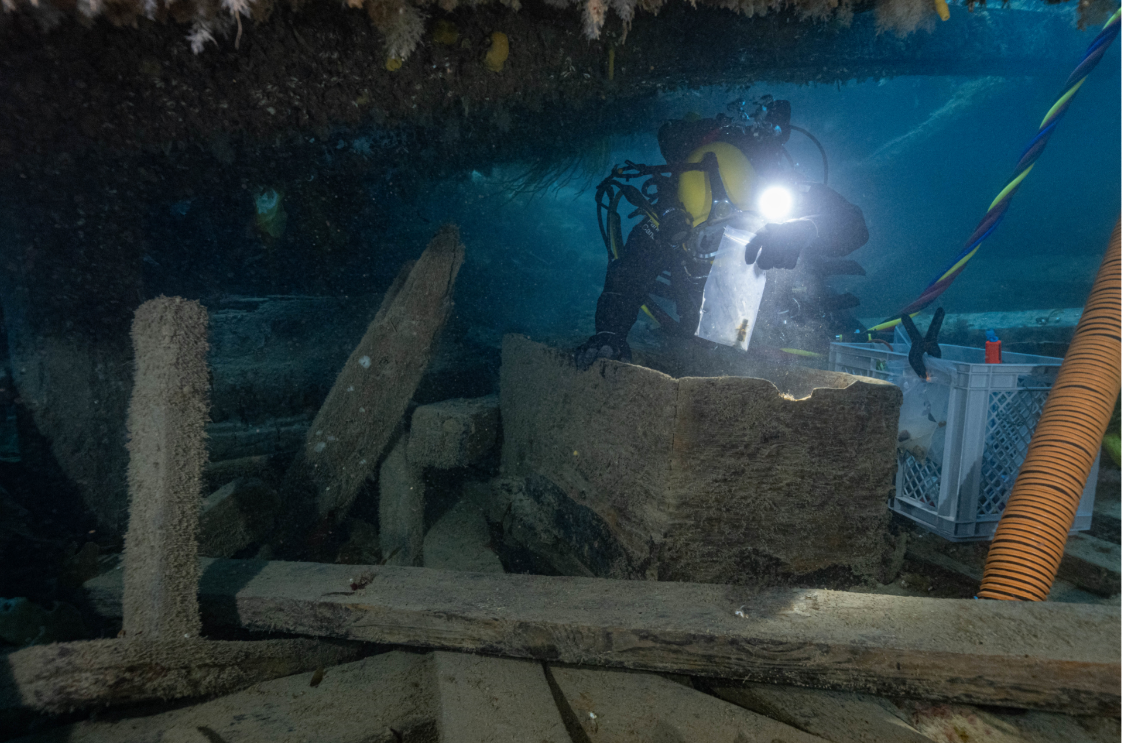
Parks Canada underwater archaeologist Marc-André Bernier excavates a seaman’s chest in the forecastle (crew living quarters) on the lower deck of HMS Erebus on Sept. 14, 2023. He holds a recovered medicinal vial in an artifact bag/Brett Seymour, Parks Canada
Parks Canada has concluded its summer 2023 archaeological research at the Wrecks of HMS Erebus and HMS Terror National Historic Site in Nunavut.
The research team conducted 68 dives over 12 days to continue investigating and documenting Erebus. Carefully excavated artifacts were retrieved to help piece together more information about the 1845 Franklin Expedition, including naval technology, scientific work and life aboard the vessel.
Underwater archaeologists found items related to navigation, science and leisure in an officer’s cabin, believed to be that of Second Lieut. Henry Dundas Le Vesconte. These items included a parallel rule, intact thermometer, leather book cover and a fishing rod with a brass reel.
Other items — such as a leather shoe or boot bottom, storage jars, and a sealed pharmaceutical bottle — were found in an area believed to represent the pantry that was used by the captain’s steward. Excavation continued in a cabin believed to be that of Third Lieut. James Fairholme, in which a collection of unidentified fossils was uncovered that supplements similar fossil finds from the 2022 season.
The team began excavating a seamen’s chest in the forecastle area — where most of the crew lived — that held numerous artifacts including pistols, military items, footwear, medicinal bottles and coins.
Recovered artifacts will be studied in Ottawa and undergo conservation treatment before many are returned for display at the Nattilik Heritage Centre in Gjoa Haven (Uqsuqtuuq), Nunavut.
The archaeologists also captured thousands of high-resolution digital photos that will be used to produce highly accurate three-dimensional models to better understand how the site is changing.
Research activities concluded Sept. 18 and the team, on the Research Vessel David Thompson and with the excavation support barge Qiniqtiryuaq, returned to Gjoa Haven on Sept. 20. The team then made a short visit to the wreck of HMS Terror to conduct remote sensing recording, using the ship’s multi-beam echosounder and sub-bottom profiler. This included surveying of the wreck to capture a snapshot of its condition and widening the mapping of a vessel access corridor into this mostly uncharted bay.
On Sept. 21, Parks Canada held an event at the Nattilik Heritage Centre to share some of the 2023 discoveries with the community. It continues to collaborate with the Nattilik Heritage Society and its Wrecks Guardian Program on a variety of initiatives, including active site surveillance during the summer and ongoing terrestrial archaeological research with Inuit Heritage Trust.
The Franklin story began in May 1845 when Sir John Franklin left England in command of the Royal Navy’s most ambitious Northwest Passage expedition with 128 men on the Erebus and the Terror to find the rumoured shortcut to the Far East. The ships were last seen in July by whalers in Lancaster Sound within the Inuit homeland in what’s now Nunavut.
The explorers battled ice, scurvy, tuberculosis and lead poisoning from improperly tinned food. Some resorted to survival cannibalism before they all died over the next few years. The graves of Petty Officer John Torrington, Royal Marine Private William Braine and Able Seaman John Hartnell were found at what's now Beechey Island National Historic Site, where Franklin’s men had overwintered on their ships.
The Erebus wreck was discovered in 2014 and the Terror wreck was found in 2016. The national historic site is co-managed by Parks Canada and the Nattilik Heritage Society.
“The Franklin expedition remains one of the most popular mysteries from the nineteenth century,” Steven Guilbeault, Minister of Environment and Climate Change and Minister responsible for Parks Canada, said in a news release. “However, thanks to the important work of Parks Canada and Inuit partners, pieces of this mysterious puzzle are being retrieved allowing us to better understand the fascinating events of this incredible expedition.”
Parks Canada is one of the principal cultural resource management organizations in Canada and is the Government of Canada lead for matters and programs related to built and archaeological heritage.
Collaborating with numerous Indigenous groups across Canada, Parks Canada and Indigenous peoples are partners in conserving natural and cultural heritage and sharing the stories of these treasured places, including the Erebus and Terror wrecks.
The Nattilik Heritage Society administers the Wrecks Guardian Program, and the Nattilik Heritage Centre Expansion project to house a new exhibition in 2025.
Recovered artifacts from the Franklin expedition are co-owned by Parks Canada and the Inuit Heritage Trust.
Following the historic gift of the Erebus and Terror wrecks to Canada by the United Kingdom in 2018, Parks Canada will transfer a sample of Erebus artifacts to the National Museum of the Royal Navy starting in 2024. These artifacts, including a ship’s bell and a cannon, were retained by the United Kingdom as a representative sample.
On March 2, the Government of Canada and the Kitikmeot Inuit Association signed a $23 million ($17 million USD) Inuit Impact and Benefit Agreement for the site. The agreement sets out a new model for a cooperative relationship and supports economic development opportunities for Inuit in Gjoa Haven and Cambridge Bay.
Stantec, a global leader in sustainable design and engineering, recently provided hydrological and storm modeling to Parks Canada. This research will help Parks Canada understand climate change-related threats to the wrecks and what mitigation measures may be needed.


